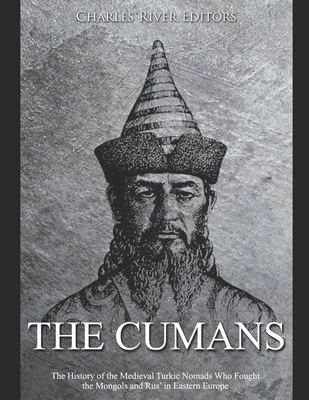The Cumans: The History of the Medieval Turkic Nomads Who Fought the Mongols and Rus' in Eastern Europe

The Cumans: The History of the Medieval Turkic Nomads Who Fought the Mongols and Rus' in Eastern Europe
*Includes pictures
*Includes excerpts of medieval accounts
*Includes a bibliography for further reading
"Let us begin this narration, brethren, from the old times of Vladimir to this present time of Igor, who strengthened his mind with courage, who quickened his heart with valorand, thus imbued with martial spirit, led his valiant regimentsagainst the Kuman landin defense of the Russian land." - The Tale of Igor's Campaign
Before the Mongols rode across the steppes of Asia and Eastern Europe, the Cumans were a major military and cultural force that monarchs from China to Hungary and from Russia to the Byzantine Empire faced, often losing armies and cities in the process. The Cumans were a tribe of Turkic nomads who rode the steppes looking for plunder and riches, but they rarely stayed long after they got what they wanted.
From the late 9th century until the arrival of the Mongols in 1223, there was virtually nothing that could be done to stop the Cumans. Old Russian chronicles, Byzantine texts, Western European chronicles, and travel diaries of Islamic scholars all reveal that the Cumans were a threat to any kingdom in their path. Some kingdoms chose to fight the Cumans and often suffered heavy destruction, while others believed buying them off was the more reasonable course of action. The latter course often brought them into intimate contact with the most powerful kingdoms of medieval Eastern Europe before the Cumans were eventually replaced by the Mongols, with the remaining Cumans dispersing and integrating into various European and central Asian kingdoms in the 13th century. Many Cumans joined the Mongol Golden Horde and later became Muslims, while some helped found dynasties in Bulgaria, Hungary, and Romania.
The Cumans came from somewhat mysterious origins before they became the western vanguard of a massive nomadic horde that grew in ferocity and effectiveness as the centuries passed, but they were far more than mindless barbarians interested in violence alone. Although violence did play a major role in early Cuman culture, sources reveal they were also interested in diplomacy and eventually integrated with their sedentary neighbors. Archaeological discoveries further indicate that their culture was unique, complete with mythology and some art, but in the end, the Cumans disappeared as quickly as they appeared on the historical scene, much like other nomadic peoples before and after them.
The Cumans: The History of the M
PRP: 86.34 Lei
Acesta este Pretul Recomandat de Producator. Pretul de vanzare al produsului este afisat mai jos.
77.71Lei
77.71Lei
86.34 LeiLivrare in 2-4 saptamani
Descrierea produsului
*Includes pictures
*Includes excerpts of medieval accounts
*Includes a bibliography for further reading
"Let us begin this narration, brethren, from the old times of Vladimir to this present time of Igor, who strengthened his mind with courage, who quickened his heart with valorand, thus imbued with martial spirit, led his valiant regimentsagainst the Kuman landin defense of the Russian land." - The Tale of Igor's Campaign
Before the Mongols rode across the steppes of Asia and Eastern Europe, the Cumans were a major military and cultural force that monarchs from China to Hungary and from Russia to the Byzantine Empire faced, often losing armies and cities in the process. The Cumans were a tribe of Turkic nomads who rode the steppes looking for plunder and riches, but they rarely stayed long after they got what they wanted.
From the late 9th century until the arrival of the Mongols in 1223, there was virtually nothing that could be done to stop the Cumans. Old Russian chronicles, Byzantine texts, Western European chronicles, and travel diaries of Islamic scholars all reveal that the Cumans were a threat to any kingdom in their path. Some kingdoms chose to fight the Cumans and often suffered heavy destruction, while others believed buying them off was the more reasonable course of action. The latter course often brought them into intimate contact with the most powerful kingdoms of medieval Eastern Europe before the Cumans were eventually replaced by the Mongols, with the remaining Cumans dispersing and integrating into various European and central Asian kingdoms in the 13th century. Many Cumans joined the Mongol Golden Horde and later became Muslims, while some helped found dynasties in Bulgaria, Hungary, and Romania.
The Cumans came from somewhat mysterious origins before they became the western vanguard of a massive nomadic horde that grew in ferocity and effectiveness as the centuries passed, but they were far more than mindless barbarians interested in violence alone. Although violence did play a major role in early Cuman culture, sources reveal they were also interested in diplomacy and eventually integrated with their sedentary neighbors. Archaeological discoveries further indicate that their culture was unique, complete with mythology and some art, but in the end, the Cumans disappeared as quickly as they appeared on the historical scene, much like other nomadic peoples before and after them.
The Cumans: The History of the M
Detaliile produsului









